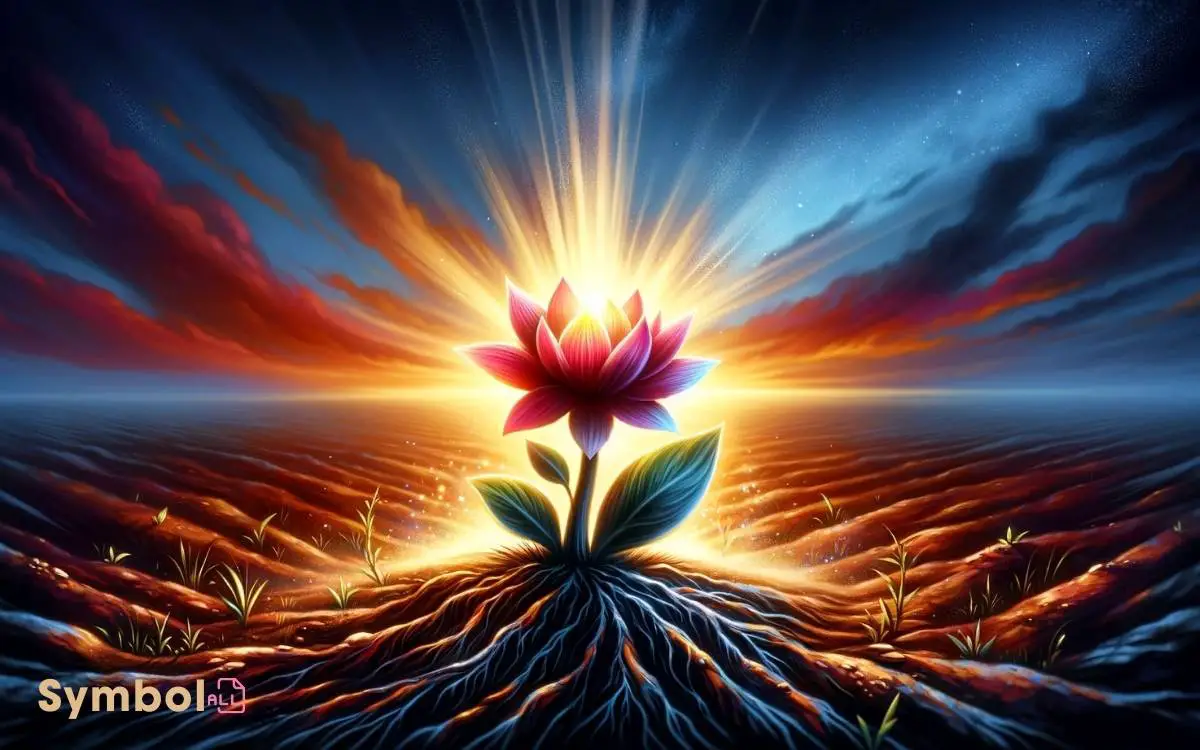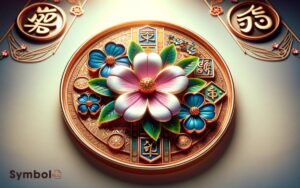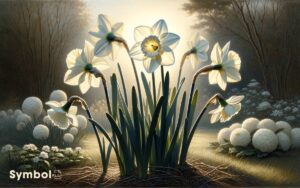What Flower Is a Symbol of Hope? Snowdrop, Lotus!
The snowdrop, lotus, and anemone signify hope, embodying renewal, resilience, and the promise of brighter days.
These flowers, steeped in ancient symbolism, have evolved through epochs, reflecting hope in myriad cultures.
Each flower’s botanical and cultural narratives underscore its significance as a hope emblem. Exploring these stories further reveals deeper insights into their enduring roles as symbols of hope across time and traditions.

Key Takeaways
6 Flowers That Symbolize Hope
| Flower Name | Symbolism of Hope | Description | Origin |
|---|---|---|---|
| Daffodil | New beginnings | Bright yellow flowers that bloom in spring, often associated with rejuvenation and new life. | Native to northern Europe |
| Snowdrop | Consolation or hope | One of the first flowers to bloom at the end of winter, signifying hope and the coming of spring. | Found across Europe and the Middle East |
| Bluebell | Constancy and everlasting love | Known for their bell-shaped blooms and blue color, they symbolize the persistence of love and hope through time. | Native to the British Isles |
| Iris | Faith and hope | Comes in a variety of colors, each symbolizing different meanings, with the blue iris specifically representing hope and faith. | Found worldwide, with a concentration in the Northern Hemisphere |
| Peony | Healing and life | Large, often fragrant flowers, representing healing and the hope of a happy life. | Native to Asia, Europe, and Western North America |
| White Lily | Purity and hope | Pure white lilies are commonly associated with rebirth and hope. | Originates from the temperate northern hemisphere |
The Language of Flowers
The language of flowers, also known as floriography, provides a nuanced way for individuals to express emotions and messages through the selection and arrangement of specific blooms.
This form of communication, deeply rooted in cultural and historical contexts, utilizes the inherent symbolism of various flowers to convey complex feelings and intentions without the use of words.
Each flower and its color possess a unique meaning, meticulously cataloged in floriographical dictionaries, allowing for precise emotional expression.
You’ll find that meticulous attention to detail is paramount in floriography, as variations in arrangement, number, and condition of flowers can alter the intended message significantly.
This scientific approach to understanding plant symbolism offers a fascinating insight into how humans have historically leveraged nature’s beauty to enhance interpersonal communication, fostering a deeper connection with the natural world.
Unveiling the Symbol of Hope
Understanding the language of flowers opens a pathway to discovering specific blooms that embody powerful symbols, including the flower that stands as a beacon of hope. In this particular scenario, the snowdrop emerges as a quintessential symbol.
Scientically known as Galanthus, its emergence during the late winter months serves as a herald of spring, signifying renewal and the promise of brighter days ahead.
This perennial, bulbous plant showcases delicate, drooping white flowers, which pierce through snow’s blanket, defying the cold’s harshness. Its resilience and ability to flourish under adverse conditions underscore its symbolism.
Analyzing its biological characteristics, including its growth cycle and adaptability, provides insight into why the snowdrop is universally recognized as a potent emblem of hope, resilience, and the enduring nature of life’s cycle.
Historical Significance
You’ll find that ancient cultures harbored distinct beliefs about flowers symbolizing hope, embedding these notions deeply within their rituals and art.
As you move through the ages, these symbols evolved, reflecting societal changes and philosophical growth.
Today, modern interpretations continue to draw on this rich tapestry, blending historical contexts with contemporary perspectives to understand hope’s enduring emblem.
Ancient Cultures Beliefs
Throughout history, ancient cultures have attributed significant symbolic meanings to flowers, regarding them as powerful emblems of hope in their mythologies and rituals.
The Ancient Egyptians, for instance, held the lotus in high esteem, symbolizing rebirth and the sun’s relentless cycle, embodying perpetual hope for a new day.
Similarly, the Greeks associated the anemone with the arrival of spring and the hope it brings after a barren winter.
In these contexts, flowers weren’t merely decorative; they were deeply interwoven with societal beliefs and practices, serving as metaphors for human experiences.
Analyzing these historical connections reveals a universal tendency to look towards nature for symbols of hope, resilience, and renewal, underscoring an innate human desire to find solace and encouragement in the natural world.
Symbols Through Ages
Building on the foundation of ancient cultural beliefs, the historical significance of flowers as symbols of hope evolves markedly through different epochs.
As societies progressed, the symbolic meanings attributed to flowers underwent a transformation, influenced by religious texts, folklore, and the arts.
Scientific analysis reveals that during the Middle Ages, specific flowers began to hold unique positions within cultural narratives, often tied to religious symbolism and the human condition’s perseverance.
The Renaissance period further amplified this, as botany emerged as a science, leading to a deeper understanding and classification of flora.
This period saw an increase in the depiction of flowers in art and literature, serving not only as embellishments but as coded messages of hope, resilience, and renewal.
Through meticulous documentation and artistic representation, the enduring link between flowers and hope was cemented, reflecting humanity’s intrinsic connection to nature.
Modern Interpretations
In contemporary times, a diverse array of flowers continues to symbolize hope, each with its own unique historical backstory and significance.
You’ll find that modern interpretations of these symbols often draw on their deep-rooted historical contexts, reflecting a blend of cultural traditions and scientific understanding.
For instance, the daffodil, with its bright, resilient blooms emerging early in spring, serves as a potent emblem of renewal and the overcoming of adversity. Scientific analysis reveals that its hardiness and ability to thrive in adverse conditions mirror human resilience.
Similarly, the lotus flower, revered for its ability to rise immaculately above murky waters, symbolizes purity and enlightenment alongside hope.
These interpretations aren’t arbitrary but are grounded in observable characteristics and behaviors of the flowers, offering a thorough understanding of their symbolism in contemporary society.
A Mythological Perspective
Delving into mythology reveals that various cultures have revered flowers as symbols of hope, each with its own unique story and significance.
- In ancient Greek mythology, the anemone flower emerged from the tears of Aphrodite as she mourned Adonis, symbolizing the hope of renewal and rebirth amidst sorrow.
- Similarly, the lotus in Egyptian mythology, rising pristine from murky waters, represents the hope of purity and enlightenment. These narratives underscore a universal theme: the resilience of hope in the face of adversity.
Scientific analysis of these myths shows a deep understanding of human psychology and the natural world.
Flowers, through their life cycles and beauty, encapsulate the perennial human hope for a better tomorrow, illustrating how deeply entwined they’re with our collective psyche and natural phenomena.
Cultural Representations Worldwide
Exploring cultural representations worldwide, we find that flowers symbolize hope across various societies, each embedding this concept within its unique traditions and beliefs.
- In Japan, the cherry blossom, or Sakura, epitomizes the transient nature of life, paralleled with hope in the face of impermanence.
- Similarly, the lotus in Eastern cultures, rising unblemished from muddy waters, signifies purity, enlightenment, and the hope of overcoming adversities.
- In Western traditions, the olive branch represents hope and peace, a symbol deeply rooted in ancient mythology and subsequently adopted in various cultural narratives.
Analyzing these examples, it’s evident that the symbolism of hope in flowers transcends mere aesthetic appreciation, integrating itself in the cultural fabric as a confirmation to resilience, renewal, and the enduring human spirit.
The Daffodil: A Closer Look
Among various symbols of hope, the daffodil stands out for its distinctive biological and cultural significance, embodying the essence of renewal and resilience.
Scientifically known as Narcissus, this genus comprises perennial plants, primarily hailing from Europe and North Africa.
The daffodil’s morphology is striking; it features a central trumpet-shaped corona surrounded by six floral leaves, often referred to as the ‘perianth.’
This unique structure isn’t merely aesthetic it plays a vital role in the plant’s reproductive process, facilitating pollination.
Additionally, daffodils exhibit a chromatic range from vibrant yellows to subtle whites, each hue contributing to its symbolic representation of hope.
Their early spring blooming period further underscores their emblematic association with new beginnings and the triumph over adversity.
Growing Conditions and Care
Understanding the biological and cultural significance of the daffodil naturally leads us to contemplate its ideal growing conditions and care requirements for healthy development and bloom.
Ideal growth necessitates well-drained soil, with a slight acidic to neutral pH, ideally ranging between 6.0 and 7.0.
Daffodils thrive under full to partial sunlight, requiring at least six hours of direct sunlight daily. It’s vital to plant the bulbs in autumn, about 2 to 4 inches deep and 3 to 6 inches apart, to guarantee they establish roots before the frost.
During the growing season, regular watering supports their development, yet it’s crucial to avoid waterlogging, as this can lead to bulb rot.
Post-bloom, it’s important to let the foliage naturally yellow and wither, as premature removal can weaken the bulb for the following year.
Varieties and Colors
Daffodils, with their diverse varieties and colors, offer a captivating exploration in genetic diversity and adaptability, presenting a range of options for gardeners and botanists alike.
You’ll find that these flowers don’t just come in the classic yellow; they span a spectrum from white to orange, and even pink.
Through selective breeding, over 13,000 varieties have been developed, each with distinctive characteristics.
| Variety | Color |
|---|---|
| Trumpet | Yellow, White, Orange |
| Cyclamineus | Pink, White, Yellow |
| Double | Multi-colored, White |
This table highlights the diversity within just a few categories, emphasizing the adaptability and wide-ranging appeal of daffodils.
As you explore the scientific aspects of these varieties, you’ll appreciate the intricate relationships between genetics, environmental factors, and human selection that have shaped the daffodil’s evolution.
In Literature and Art
In the domain of literature and art, daffodils have been a significant symbol, deeply analyzed for their recurring motifs and meanings across various works.
You’ll find that poets and artists frequently employ this flower to represent renewal, the triumph of hope over despair, and the unyielding resilience of the human spirit.
For instance, William Wordsworth‘s ‘I Wandered Lonely as a Cloud’ vividly harnesses the imagery of daffodils dancing in the breeze to invoke a sense of blissful solitude intertwined with hopeful anticipation.
Similarly, in visual arts, daffodils are often depicted in scenes portraying rebirth and new beginnings, offering a visual metaphor for hope.
This detailed examination reveals how daffodils transcend mere aesthetic appreciation, embodying complex themes of hope and resilience that resonate deeply within human experience.
Gardening Tips for Hope
To cultivate daffodils that embody hope, you’ll need to guarantee prime growing conditions, starting with well-draining soil and full sun exposure. Daffodils thrive in zones 3-9, adapting to a wide range of climates but they demand specific care.
Plant bulbs at a depth thrice their height, ensuring adequate space for root expansion. This strategic depth fosters robust root systems, essential for nutrient uptake and overall plant health.
Incorporate organic matter into the soil to improve fertility and structure, enhancing water retention and drainage balance. Regular watering is important, particularly during dry spells, but avoid waterlogging to prevent bulb rot.
A slow-release bulb fertilizer applied at planting and again in early spring supports vigorous growth. Monitoring for pests and diseases is crucial; prompt intervention can mitigate damage and preserve your hopeful blooms.
Celebrations and Festivals
Throughout the world, various celebrations and festivals have embraced daffodils as symbols of hope, integrating them into ceremonies that mark renewal and resilience.
In the UK, for example, the arrival of spring is often celebrated with daffodils prominently displayed, reflecting the end of winter’s dormancy and the return of vitality.
Scientifically, this tradition is rooted in the plant’s lifecycle, as daffodils are among the first flowers to bloom, signaling the onset of spring. Their resilient nature, thriving in adverse conditions, further cements their role as emblems of hope.
In addition, in cancer fundraisers globally, the daffodil symbolizes strength and courage in the face of illness, embodying hope for a future free from cancer. These practices underscore the flower’s universal appeal as a beacon of hope and renewal.
Other Flowers of Hope
You’ll find that beyond the commonly recognized symbols of hope, several other flowers carry this profound message through their biology and cultural significance.
The snowdrop, emerging in early spring, serves as a biological indicator of warmer days ahead, embodying hope in its very growth cycle.
Similarly, the daffodil and lotus represent rebirth and renewal, and purity amidst adversity, respectively, demonstrating through their unique adaptations and historical symbolism how nature’s resilience mirrors our own.
Snowdrop: Early Spring Hope
Amidst the cold vestiges of winter, the snowdrop emerges as a harbinger of hope, symbolizing the imminent arrival of spring with its delicate white petals.
This tiny, resilient plant isn’t just a marvel of beauty; it’s a botanical phenomenon, bursting through frozen soil when most life lies dormant.
- Galanthus Nivalis: Scientifically known as Galanthus nivalis, the snowdrop is one of the first flowers to bloom, often appearing while snow still blankets the ground.
- Adaptation: Its ability to penetrate frosty grounds is due to a specialized leaf tip, equipped with a hardy covering.
- Symbolism: Beyond its botanical interest, snowdrops carry a profound message of renewal and hope, their pristine white blossoms breaking the monotony of winter’s grayscale landscape, promising the rejuvenation of spring.
Daffodil: Rebirth and Renewal
Embodying the essence of rebirth and renewal, the daffodil stands out as a vibrant symbol of hope with its bright yellow blooms signaling the advent of spring.
| Aspect | Detail | Significance |
|---|---|---|
| Color | Bright Yellow | Symbolizes sunlight, warmth |
| Blooming Season | Early Spring | Marks renewal, new beginnings |
| Perennial Nature | Returns every year | Represents resilience, enduring hope |
| Cultural Symbol | Associated with spring festivals | Celebrates life, growth |
Daffodils, with their botanical name Narcissus, are not just visually striking; their lifecycle and cultural significance contribute to their symbolism.
They endure through the harshest winters, buried under the snow, only to emerge with the first signs of spring.
This resilience, coupled with their perennial nature, illustrates the concept of hope as an enduring, ever-renewable resource, grounded in the cycles of nature.
Lotus: Purity Amidst Adversity
The lotus flower, revered across various cultures, symbolizes purity and enlightenment, thriving in muddy waters to bloom with remarkable beauty.
This resilience and ability to emerge unscathed from adversity make it a powerful symbol of hope.
Consider these aspects:
- Biological resilience: The lotus’s growth, from murky waters to an unblemished flower, mirrors the process of overcoming challenges.
- Symbolic significance: Culturally, it represents purity of heart and mind, despite external conditions.
- Adaptive strategies: Its leaves and petals are superhydrophobic, repelling water and mud, ensuring the plant remains clean.
This analysis reveals how the lotus embodies hope by maintaining its integrity and beauty in the face of hardship, offering a profound lesson on resilience and purity.
Conclusion
In the intricate tapestry of flora, the snowdrop emerges as a beacon of hope, its delicate petals defying winter’s harsh embrace.
This allegory of resilience, woven into the fabric of cultures and stories, reflects humanity’s perpetual quest for light in darkness.
Analyzing its biological resilience and symbolic potency, one understands that hope, much like the snowdrop, thrives in adversity, offering a reminder of renewal and the enduring strength of the human spirit amidst the cycles of life.





